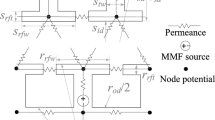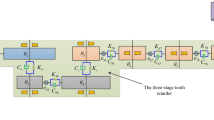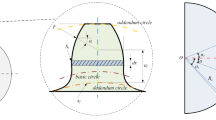Abstract
This study develops a method to suppress the mechanical vibrations of a motor–gear transmission system (MGTS) due to speed and external load variations. It also achieves soft starting of the drive motor using a magnetorheological fluid coupling (MRFC) with variable stiffness and damping instead of the traditional rigid coupling. Therefore, a mechanical–electromagnetic coupled dynamics model of an MGTS is established, which includes a drive motor, a gear transmission system, an MRFC, and a load. Based on the developed dynamics model, the effects of the MRFC on the dynamic response of the MGTS at different coil currents in the startup and stable operation stages of the drive motor are investigated. The results show that as the coil current increases, the coil current overshoot increases, and the overshoot duration is 0.125 s. When the current is 2.0 A, the coil current overshoot reaches a maximum, and the overshoot rate is 8.84%. Concurrently, when the coil current increases from 0.5 to 2.0 A, the magnetic field intensity in the MRF working area increases from 0.38 to 0.74 T, the torque increases from 70 to 115 N·m, and the response time of the MRFC reduces from 0.125 to 0.002 s. Moreover, the relative vibration center offset rates (RVCORs) in the x, y, and θ directions of nodes 4, 8, 10, and 15 gradually decrease with increasing coil current. However, these RVCORs reach maximum when the coil current is 2.0 A, with those in the x direction being 0.586%, 0.447%, 0.446%, and − 0.263%, respectively, and in the y direction being 0.586%, 0.451%, 0.497%, and − 0.264%, respectively. The RVCORs of the helical gear meshing node of the MGTS in the θ direction are 0.0722%. Furthermore, the maximum vibration amplitude reduction rates (MVARRs) in the x, y, and θ directions of nodes 4, 8, 10, and 15 gradually increase with increasing coil current. The MVARRs of each node reach the maximum when the coil current is 2.0 A; the MVARRs of nodes 4, 8, 10, and 15 in the x direction are 40.98%, 83.4%, 83.49%, and 2.17%, respectively, and those in the y direction are 64.4%, 83.4%, 83.46%, and 2.16%, respectively. The MVARRs of the helical gear meshing node in the θ direction have an MVARRs of 29.1%. Moreover, the vibration amplitudes of the gear meshing node decay the fastest in the θ direction, and the decay time reduces from 2.8 to 0.3 s when the coil current increases from 0.5 to 2.0 A.




























Similar content being viewed by others
Data availability
Data sharing is not applicable to this article as no datasets were generated or analyzed during the current study.
Abbreviations
- V :
-
Coil voltage
- I :
-
Coil current
- L :
-
Coil inductance
- R :
-
Coil resistance
- V 0 :
-
Constant voltage
- t :
-
Time
- \(\tau \) :
-
Shear stress of MRF
- \(\eta \) :
-
Zero-field viscosity of MRF
- \({\tau }_{(H)}\) :
-
Dynamic yield stress of MRF
- \(\mathop \gamma \limits^{.}\) :
-
Shear strain rate of MRF
- B :
-
Magnetic flux density
- H :
-
Magnetic field intensity
- µ 0 :
-
Vacuum magnetic permeability of MRF
- µ r :
-
Relative magnetic permeability of MRF
- R 1 :
-
Radius of driven cylinder
- R 2 :
-
Radius of driving cylinder
- \(\Delta \omega \) :
-
Speed difference between input and output
- l :
-
Working gap length of MRF
- l e :
-
Effective working gap length of MRF
- E M :
-
Relative shear modulus of MRF
- \(E^{\prime }\) :
-
Storage modulus of MRF
- \(E^{\prime \prime }\) :
-
Loss modulus of MRF
- \(\varrho \) :
-
Volume fraction of MRF
- B s :
-
Magnetization intensity of MRF
- λ :
-
Loss factor
- k M :
-
Torsional stiffness coefficient of MRF
- c M :
-
Torsional damping coefficient of MRF
- J M :
-
Rotational inertia of MRFC
- C c :
-
Critical damping coefficient of MRFC
- \({\omega }_{n}\) :
-
Angular frequency
- \({\xi }_{M}\) :
-
Damping ratio
- K M :
-
Stiffness matrix of MRFC
- M M :
-
Mass matrix of MRFC
- C M :
-
Damping matrix of MRFC
- X M :
-
Displacement matrix of MRFC
- K s :
-
Stiffness matrix of shafting element
- M s :
-
Mass matrix of shafting element
- C s :
-
Damping matrix of shafting element
- X s :
-
Displacement matrix of shafting element
- e :
-
Transmission error
- \(x_{j + 1} ,\;y_{j + 1} ,\;z_{j + 1}\) :
-
Translation displacement of nodes j + 1
- \(\theta_{{x_{j} }} ,\;\theta_{{y_{j} }} ,\;\theta_{{z_{j} }}\) :
-
Rotational angular displacement of nodes j
- \(\theta_{{x_{j + 1} }} ,\;\theta_{{x_{j + 1} }} ,\;\theta_{{x_{j + 1} }}\) :
-
Rotational angular displacement of nodes j + 1
- \(m_{j} ,\;I_{{{\text{ij}}}}\) :
-
Mass and moment of inertia to nodes j
- \(m_{j + 1} ,\;I_{{{\text{ij}} + 1}}\) :
-
Mass and moment of inertia to nodes j + 1
- E :
-
Elastic modulus of shaft material
- P :
-
Moment of inertia of section
- ς :
-
Shear influence factor
- a :
-
Length of beam element
- G m :
-
Shear elastic modulus of shaft material
- A :
-
Cross-sectional area of beam element
- j :
-
Polar moment of inertia
- n :
-
Section influence coefficient
- p :
-
Mass scaling coefficients
- q :
-
Stiffness scaling coefficients
- \(\zeta_{1} ,\;\zeta_{2}\) :
-
Damping coefficient
- ω 2 :
-
Intrinsic frequency
- α :
-
Pressure angle
- γ :
-
Angle (between the gear meshing line and the y-axis)
- β b :
-
Helical angle
- r 1, r 2 :
-
Base radiuses of driving gear and driven gear
- K G :
-
Stiffness matrix of gear meshing element
- C G :
-
Damping matrix of gear meshing element
- X G :
-
Displacement matrix of gear meshing element
- M G :
-
Mass matrix of gear meshing element
- \(x_{{{\text{xi}}}} ,\;x_{{{\text{yi}}}} ,\;x_{{{\text{zi}}}}\) :
-
Translational displacement of the driving gear
- \(\theta_{Z1} ,\;\theta_{Z2}\) :
-
Rotational angular displacement
- \(x_{2} ,\;y_{2} ,\;z_{2}\) :
-
Translational displacement of the driven gear
- δ :
-
Relative total deformation
- \(x_{j} ,\;y_{j} ,\;z_{j}\) :
-
Translation displacement of nodes j
- V G :
-
Meshing matrix of helical gear pair
- m 1, m 2 :
-
Mass of the driving and driven gear
- \(I_{x1} ,\;I_{y1} ,\;I_{z1} ,\;I_{x2} ,\;I_{y2} ,\;I_{z2}\) :
-
Rotational inertia of the driving and driven gear
- f s :
-
Normal force of the helical gear pair
- k m :
-
Helical gear pair meshing stiffness
- c m :
-
Helical gear pair meshing damping
- F G :
-
External excitation force column vector
- K B :
-
Stiffness matrix of bearing element
- C B :
-
Damping matrix of bearing element
- M B :
-
Mass matrix of bearing element
- X B :
-
Displacement matrix of bearing element
- k xx, k yy :
-
Radial stiffness
- k zz :
-
Axial stiffness
- \(k_{\theta x\theta x} ,\;k_{\theta y\theta y}\) :
-
Torsional stiffness
- G S :
-
Gyroscopic matrix of shaft element
- K C :
-
Stiffness matrix of connecting element
- C C :
-
Damping matrix of connecting element
- M C :
-
Mass matrix of connecting element
- X C :
-
Displacement matrix of connecting element
- T in :
-
Input torque of drive motor
- T load :
-
Load torque
- M :
-
Mass matrix of MGTS
- K :
-
Stiffness matrix of MGTS
- C :
-
Damping matrix of MGTS
- X(t):
-
Whole displacement vector of MGTS
- F(t):
-
System external load column vector
- T :
-
MRF transmission torque of MRFC
- T L :
-
Load torque
- Xx :
-
Amplitude of x-direction
- Xy :
-
Amplitude of y-direction
- X θ :
-
Amplitude of θ-direction
- x o :
-
Vibration center of x-direction
- y o :
-
Vibration center of y-direction
- θ o :
-
Vibration center of θ-direction
- \(\varepsilon \) :
-
Relative vibration center offset rate
- x M :
-
Maximum vibration amplitude of x-direction
- y M :
-
Maximum vibration amplitude of y-direction
- θ M :
-
Maximum vibration amplitude of θ-direction
- \(\phi \) :
-
Amplitude reduction rate
- ρ :
-
Density of shaft material
- G G :
-
Gyroscopic matrix of helical gear pair
- \(\Omega \) :
-
Spin speed
- \({r}_{s}\) :
-
Radius of gyration
- G :
-
Whole gyroscopic matrix of MGTS
- \(\Omega_{1} ,\;\Omega_{2}\) :
-
Rotation angular speed
References
De Vicente, J., Klingenberg, D.J., Hidalgo-Alvarez, R.: Magnetorheological fluids: a review. Soft Matter 7(8), 3701–3710 (2011)
Park, B.J., Fang, F.F., Choi, H.J.: Magnetorheology: materials and application. Soft Matter 6(21), 5246–5253 (2010)
Rodríguez-López, J., Elvira, L., Resa, P., et al.: Sound attenuation in magnetorheological fluids. J. Phys. D Appl. Phys. 46(6), 065001 (2013)
Ahamed, R., Choi, S.-B., Ferdaus, M.M.: A state of art on magneto-rheological materials and their potential applications. J. Intell. Mater. Syst. Struct. 29(10), 2051–2095 (2018)
Lee, C.H., Lee, D.W., Choi, J.Y., et al.: Tribological characteristics modification of magnetorheological fluid. J Tribol 133(3), 031801 (2011)
Olivier, M., Pacifique, T., Jongseok, O., et al.: Design and analysis of a hybrid annular radial magnetorheological damper for semi-active in-wheel motor suspension. Sensors 22(10), 3689 (2022)
Kobayashi, M., Shi, F., Maemori, K.-I.: Modeling and parameter identification of a shock absorber using magnetorheological fluid. J. Syst. Des. Dyn. 3, 804–813 (2009)
Ashok, K.K., Hemantha, K., Arun, M.: Effect of temperature on sedimentation stability and flow characteristics of magnetorheological fluids with damper as the performance analyser. J. Magn. Magn. Mater. 555, 169342 (2022)
Zhongqiang, F., Dong, Y., Zhaobo, C., et al.: An improved constant deceleration control method with extended shock velocity range for magnetorheological energy absorber. J. Intell. Mater. Syst. Struct. 33(12), 1513–1526 (2021)
Yi, Y., Qin, D., Liu, C.: Investigation of electromechanical coupling vibration characteristics of an electric drive multistage gear system. Mech. Mach. Theory 121, 446–459 (2018)
Liu, C., Yin, X., Liao, Y., et al.: Hybrid dynamic modeling and analysis of the electric vehicle planetary gear system. Mech. Mach. Theory 150, 103860 (2020)
Chen, X., Hu, J., Chen, K., et al.: Modeling of electromagnetic torque considering saturation and magnetic field harmonics in permanent magnet synchronous motor for HEV. Simul. Model. Pract. Theory 66, 212–225 (2016)
Jiang, S., Li, W., Wang, Y., et al.: Study on electromechanical coupling torsional resonance characteristics of gear system driven by PMSM: a case on shearer semi-direct drive cutting transmission system. Nonlinear Dyn. 104(2), 1205–1225 (2021)
Jiang, Y., Zhu, H., Li, Z., et al.: The nonlinear dynamics response of cracked gear system in a coal cutter taking environmental multi-frequency excitation forces into consideration. Nonlinear Dyn. 84(1), 203–222 (2015)
Zhu, W., Wu, S., Wang, X., et al.: Harmonic balance method implementation of nonlinear dynamic characteristics for compound planetary gear sets. Nonlinear Dyn. 81(3), 1511–1522 (2015)
Li, Z., Peng, Z.: Nonlinear dynamic response of a multi-degree of freedom gear system dynamic model coupled with tooth surface characters: a case study on coal cutters. Nonlinear Dyn. 84(1), 271–286 (2015)
Wang, J., He, G., Zhang, J., et al.: Nonlinear dynamics analysis of the spur gear system for railway locomotive. Mech. Syst. Signal Process. 85, 41–55 (2017)
Li, S., Wu, Q., Zhang, Z.: Bifurcation and chaos analysis of multistage planetary gear train. Nonlinear Dyn. 75(1), 217–233 (2014)
Zhibo, G., Junyang, L., Ke, X., et al.: Analysis on the vibration reduction for a new rigid–flexible gear transmission system. J. Vib. Control 28(17–18), 2212–2225 (2022)
Lee, Y.K., Jun, J.H., Choi, C.S.: Damping capacity in Fe-Mn binary alloys. Trans. Iron Steel Inst. Japan 37(10), 1023–1030 (1997)
Ma, H., Yang, J., Song, R., et al.: Effects of tip relief on vibration responses of a geared rotor system. Proc. Inst. Mech. Eng. Part C J. Mech. Eng. Sci. 228(7), 1132–1154 (2014)
Bonori, G., Barbieri, M., Pellicano, F.: Optimum profile modifications of spur gears by means of genetic algorithms. J. Sound Vib. 313(3), 603–616 (2008)
Xu, G., Dai, N., Tian, S.: Principal stress lines based design method of lightweight and low vibration amplitude gear web. Math. Biosci. Eng. 18(6), 7060–7075 (2021)
Xiao, W., Li, J., Wang, S., et al.: Study on vibration suppression based on particle damping in centrifugal field of gear transmission. J. Sound Vib. 366, 62–80 (2016)
Ramadani, R., Belsak, A., Kegl, M., et al.: Topology optimization based design of lightweight and low vibration gear bodies. Int. J. Simul. Modell. 17, 92–104 (2018)
Wang, Y.-L., Cao, D. Q., Wang, Q.-Y., et al.: Torsional vibration suppression of a gear system installed with a damping ring (2017)
Bossis, G., Lacis, S., Meunier, A., et al.: Magnetorheological fluids. J. Magn. Magn. Mater. 252, 224–228 (2002)
Huang, J., Zhang, J.Q., Yang, Y., et al.: Analysis and design of a cylindrical magneto-rheological fluid brake. J. Mater. Process. Technol. 129(1–3), 559–562 (2002)
Hoang, N., Zhang, N., Du, H.: An adaptive tunable vibration absorber using a new magnetorheological elastomer for vehicular powertrain transient vibration reduction. Smart Mater. Struct. 20(1), 015019 (2010)
Hoang, N., Zhang, N., Du, H.: A dynamic absorber with a soft magnetorheological elastomer for powertrain vibration suppression. Smart Mater. Struct. 18(7), 074009 (2009)
Shu, R., Wei, J., Tan, R., et al.: Investigation of dynamic and synchronization properties of a multi-motor driving system: theoretical analysis and experiment. Mech. Syst. Signal Process. 153, 107496 (2021)
Zhang, A., Wei, J., Shi, L., et al.: Modeling and dynamic response of parallel shaft gear transmission in non-inertial system. Nonlinear Dyn. 98(2), 997–1017 (2019)
Chen, S., Tang, J., Li, Y., et al.: Rotordynamics analysis of a double-helical gear transmission system. Meccanica 51(1), 251–268 (2016)
Wei, J., Zhang, A., Qin, D., et al.: A coupling dynamics analysis method for a multistage planetary gear system. Mech. Mach. Theory 110, 27–49 (2017)
Hu, Z., Tang, J., Zhong, J., et al.: Frequency spectrum and vibration analysis of high speed gear-rotor system with tooth root crack considering transmission error excitation. Eng. Fail. Anal. 60, 405–441 (2016)
Shu, R.: Electromechanical coupling dynamic characteristic and optimization of new shearer cutting short-range transmission system. Chongqing University (2018)
Xiong, Y., Huang, J.: A novel magnetorheological braking system with variable magnetic particle volume fractioncontrolled by utilizing shape memory alloy. J. Intell. Mater. Syst. Struct. 34, 3–14 (2022)
Acknowledgements
The authors would like to gratefully acknowledge the National Natural Science Foundation of China (51905060); Open Fund of the State Key Laboratory of Mechanical Transmission (SKLMT-MSKFKT-202119); China’s National Natural Science Foundation (52275052/51905064/52105245/51875068); China Postdoctoral Science Foundation (2021M700619/2022MD713697); Natural Science Foundation Project of Chongqing Science and Technology Commission (cstc2020jcyj-msxmX0346/cstc2021jcyj-msxmX0361);Science and Technology Research Program of Chongqing Municipal Education Commission (KJQN201901107).
Author information
Authors and Affiliations
Corresponding author
Additional information
Publisher's Note
Springer Nature remains neutral with regard to jurisdictional claims in published maps and institutional affiliations.
Rights and permissions
Springer Nature or its licensor (e.g. a society or other partner) holds exclusive rights to this article under a publishing agreement with the author(s) or other rightsholder(s); author self-archiving of the accepted manuscript version of this article is solely governed by the terms of such publishing agreement and applicable law.
About this article
Cite this article
Gong, H., Shu, R., Xiong, Y. et al. Dynamic response analysis of a motor–gear transmission system considering the rheological characteristics of magnetorheological fluid coupling. Nonlinear Dyn 111, 13781–13806 (2023). https://doi.org/10.1007/s11071-023-08585-6
Received:
Accepted:
Published:
Issue Date:
DOI: https://doi.org/10.1007/s11071-023-08585-6




